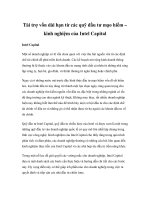Chapter2: Capital raising operations
Bạn đang xem bản rút gọn của tài liệu. Xem và tải ngay bản đầy đủ của tài liệu tại đây (688.85 KB, 33 trang )
Chapter2: Capital raising
operations
Nguyen Thi Hai Hang, Msc
Faculty of Finance and Banking
University of Economics and Law
Chapter expected learning outcomes
Review two methods of raising capital in commercial
banks
Analyse the methods of raising capital of Vietnam’s
commercial banks
Understand the processes, procedures and the
advantages and disadvantages of raising capital
through deposits and the issuance of valuable
papers.
Plan the capital mobilization strategies of
commercial banks in Vietnam in a practical context.
2
References
Circular
49/2018 / TT-NHNN regulating term
deposits, Circular 48/2018 / TT-NHNN regulating
savings deposits
Circular 34/2013 / TT-NHNN and 16/2016 / TT-
NHNN of the SBV stipulating the issuance of
promissory notes, treasury bills, certificates of
deposit, domestic bonds of credit institutions and
foreign bank branches.
3
Balance Sheet of All Commercial Banks in US
(items as a percentage of the total, Dec 2008)
The balance sheet of Vietnam banks
ASSETS
Cash on hand, gold, silver and
gemstones
Value
LIABILITIES AND
SHAREHOLDERS' EQUITY
Amounts due to the Government
and the State Banks
Balances with the State Banks
Balances with and loans to other
credit institutions
Deposits and borrowings from
other credit institutions
Trading securities
Deposits from customers
Derivative financial instruments
and other financial assets
Funds for finance, entrusted
investments and entrusted loans
Loans to customers
Investment securities
Valuable papers issued
Capital contributions, long-term
investments
Fixed assets
Other assets
Other liabilities
Value
Off-Balance Sheet Activities
Loan commitments
Obligation of bank to provide a specified
loan amount to a particular business upon
request
Note issuance facility (NIF)
Banks earn fee income for risk assumed
Standby letters of credit (SLC)
Backs a customer’s obligation to a third
party
Banks earn fee income
6
Off-Balance Sheet Activities
Forward contracts
Agreement between a customer and bank
to exchange one currency for another on a
particular future date at a specified
exchange rate
Allows customers to hedge their exchangerate risk
7
Off-Balance Sheet Activities
Swap contracts
Two parties agree to periodically exchange
interest payments on a specified notional
amount of principal
Banks serve as intermediaries or dealer
and/or guarantor for a fee
8
The balance sheet of Vietnam banks
OFF-BALANCE SHEET ITEMS:
Credit guarantees
Foreign exchange commitments
Letters of credit
Other guarantees
Other commitments
Fund mobilization of commercial banks
The mobilized capital is the capital attracted through the
Bank's operations.
It is the main source of capital in bank’s activities,
which is composed of the following components:
Deposit
Mobilize by issuing valuable papers such as promissory
notes, bonds, deposit certificates and other valuable
papers.
10
Fund mobilization of commercial banks
FUND
MOBILIZATION
Valuable
papers
Deposit
Demand Time Saving Margin
deposit deposit Deposit deposit
CDs
11
Promis
-sory
notes
Bond
Others
AS A BANKER:
INTRODUCTION TO EACH TYPE OF
DEPOSIT IN YOUR BANK
Purpose
Characteristics
Unilities
PROCEDURES FOR OPENING AN
ACCOUNT
12
Savings deposit:
United States
Vietnam
To earn interest and
accumulate capital to achieve
future goals
Hold for or mature at a
specified time
To earn interest, hold by
individuals
Tenor: n/a
Interest rate: equal/less
than that of time deposit
Keep the ability to withdraw
funds at any time (without
interest or with a lower
interest rate).
Tenor: Maximum 60 months
Interest rate: attractive, tenor
dependent, normally equal to
13
that of time deposit.
Savings deposit
Link:
Fund can be transferred from savings
account to transaction account for
payment purpose
Other functions: used as collateral for
loans, credit card…
14
OPENING PAYMENT ACCOUNTS
Subjects
Individual:
1. 18+ years old + have
appropriate civil act
capacity
2. From 15 - <18, not
losing
or
being
restricted in civil act
capacity + have own
assets
3. Other: through their
guardian or legal
representative
Entities that are legally
established, operate in
accordance with Vietnam
laws and regulations
shall be permitted to
open payment accounts
at banks
15
OPENING PAYMENT ACCOUNTS
Personal payment account:
An application for opening a payment account
ID card or valid passport, birth certificate (under
the age of 14), entry visa (foreigner) of the
account holder
In case through guardian or legal representative:
ID card + documentations of the legal
epresentative capacity of such person to the
account holder.
16
OPENING PAYMENT ACCOUNTS
Corporate payment account:
An application for opening a payment account
Documents proving that the applicant is legally
established and operate: Establishment Decision,
Operation License, Corporate Registration Certificate,
etc…
Documentations of the capacity for legal
representative, enclosing with ID card or valid
passport of such person
An appointment decision, enclosing with ID card or
valid passport of the chief accountant of the entity
applying for the opening of payment account.
17
OPENING PAYMENT ACCOUNTS
Shared payment account:
- For individuals: the documents as personal
payment account
- For entities: the documents as corporate payment
account
Adding:
- A written agreement (or contract) on the
management and use of the shared payment
account of the holders.
18
Blockading a payment account
A written request issued by a competent regulator
There is some mistake, error in Crediting to the
customer’s payment account or a request for refund
of money is sent from the remitting payment service
supplier;
There is a sign of fraudulence, breach of laws and
regulations concerning the payment account
A written notice is serviced by one of the account
holders informing that there arises dispute among
the holders of the shared payment account.
19
End the blockage of payment account
The term of blockage expires
A written request for ending the blockage of
payment account is issued by the competent
regulator
The payment service supplier has finished handling
the mistake, error in remittance
After verification, there is no act of fraudulence or
breach of laws in regard of the payment account
A written notice made by all the holders of the
shared payment account informing that the dispute
of the shared payment account among the holders
has been solved.
20









